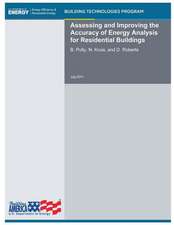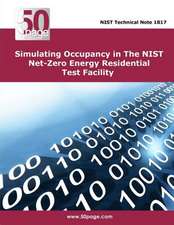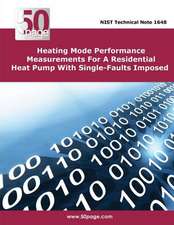Electric Utility Resource Planning: Economics, Reliability, and Decision-Making
Autor Steven Simen Limba Engleză Hardback – 14 oct 2023
- "Creating" a hypothetical electric utility
- Explaining how (and why) this utility will operate its system of generating units
- Guiding readers through a planning analysis for the utility, examining various resource options (solar, new gas-fueled generation, and conservation)
- Introducing four Fundamental Principles of Resource Planning that should guide utilities as they plan for the future
- The enormous amount of MW of new solar and batteries the utility will need to add
- Why certain characteristics of new solar and battery additions change as increasing amounts of these resources are added
- In the years prior to achieving its zero-carbon goal, how the hourly operation of the utility’s existing fossil-fueled generators, plus the new solar, will change (and why the stability of the transmission grid will be challenged)
| Toate formatele și edițiile | Preț | Express |
|---|---|---|
| Hardback (2) | 650.00 lei 6-8 săpt. | |
| CRC Press – 14 oct 2023 | 650.00 lei 6-8 săpt. | |
| CRC Press – 15 dec 2011 | 707.86 lei 6-8 săpt. |
Preț: 650.00 lei
Preț vechi: 714.28 lei
-9% Nou
Puncte Express: 975
Preț estimativ în valută:
124.39€ • 129.13$ • 103.72£
124.39€ • 129.13$ • 103.72£
Carte tipărită la comandă
Livrare economică 25 martie-08 aprilie
Preluare comenzi: 021 569.72.76
Specificații
ISBN-13: 9781032294193
ISBN-10: 1032294191
Pagini: 429
Ilustrații: 62
Dimensiuni: 156 x 234 x 31 mm
Greutate: 0.78 kg
Ediția:2
Editura: CRC Press
Colecția CRC Press
ISBN-10: 1032294191
Pagini: 429
Ilustrații: 62
Dimensiuni: 156 x 234 x 31 mm
Greutate: 0.78 kg
Ediția:2
Editura: CRC Press
Colecția CRC Press
Public țintă
GeneralCuprins
Part I: The Fundamentals of Electric Utility Resource Planning. 1. Introduction 2. How Does an Electric Utility Actually "Work" 3. Overview of Utility Resource Planning. 4. Reliability Analyses for Our Utility System. 5. Resource Option Analyses for Our Utility System: Supply Options. 6. Resource Option Analyses for Our Utility System: DSM Options. 7. Final Resource Option Analyses for Our Utility System. 8. Are We Done Yet? Other Factors Than Can (and Will) Complicate.Part II: Moving Towards Zero Carbon. 9. An Overview of Part II. 10. Moving Towards Zero Carbon: How Many MW of New Resources Will Be Needed? 11. Moving Towards Zero Carbon: Resource Planning Considerations for Solar (PV) Resources. 12. Moving Towards Zero Carbon: Resource Planning Considerations for Battery Storage Resources. 13. Moving Towards Zero Carbon: Ramifications for System Operations and Transmission Planning. 14. Final Thoughts (Including Some Opinions). Appendix A: Fundamental Principles of Electric Utility Resource Planning. Appendix B: Glossary of Terms. Appendix C: Mini-Lesson #1: Concepts of Revenue Requirements, Present. Valuing of Costs and Discount Rates, Cumulative Present Value of Revenue Requirements, and Levelized Costs. Appendix D: Mini-Lesson #2: Further Discussion of the Limitations of a Screening Curve Analytic Approach. Appendix E: Mini-Lesson #3: Further Discussion of the RIM and TRC Preliminary Cost-Effectiveness Screening Tests for DSM.
Notă biografică
Dr. Steven Sim has worked in the field of energy analysis since the mid-1970s. He graduated from the University of Miami (Florida) with bachelor’s and master’s degrees in mathematics in 1973 and 1975, respectively. He then earned a doctorate in environmental science and engineering from the University of California at Los Angeles (UCLA) in 1979 with an emphasis on energy.
During his doctoral work, Dr. Sim also completed an internship of approximately a year and a half at the Florida Solar Energy Center (FSEC), a research arm of Florida’s state university system located in Merritt Island, Florida, near Cape Canaveral. His work at FSEC involved an examination of consumers’ experience with solar water heaters and projections of the potential for renewable energy in the Southeastern United States.
In 1979, Dr. Sim joined Florida Power & Light Company (FPL), a subsidiary of NextEra Energy, Inc. FPL is one of the largest electric utilities in the United States. In the more than 40 years from 1979 to the time the 2nd edition of this book is being written, FPL has experienced tremendous population growth in the geographic area it serves. Annual average growth has been roughly 74,000 net new customer accounts per year during that period. With each customer account representing approximately 2.5 people, this represents a growth of approximately 185,000 more people per year that FPL needed to serve.
Therefore, the growth that FPL had to keep up with was roughly equivalent to 1 million new people every 5.4 years. Few, if any, other electric utilities have had to face the challenges inherent in meeting continued growth of this magnitude over such an extended time. This extraordinary growth, combined with the planning issues that all utilities face including changing environmental regulations, fuel decisions, modification/retirement of existing generating units, changes in generating technologies, etc., ensured that FPL’s planning efforts have addressed a wide variety of resource planning challenges.
During that time, Dr. Sim has had several roles in regard to FPL’s resource planning efforts. He spent approximately the first 10 years of his career at FPL designing a number of FPL’s demand side management (DSM) programs. One of these, the Passive Home Program, earned a U.S. Department of Energy (DOE) award for innovation. Among the numerous other DSM programs he either designed or co-designed were the Conservation Water Heating Program (that featured heat pump and solar water heaters) and one of the nation’s most successful load management programs (FPL’s residential load control program, known as the On Call Program, has approximately 800,000 participating customers).
In the course of designing these DSM programs, he became very interested in gaining a better understanding of how DSM programs affect FPL’s entire utility system. Of particular interest were how FPL’s DSM programs impacted the actual operation of FPL’s generation, transmission, and distribution systems, including impacts on air emissions for the FPL system as a whole, and fuel usage by all of the power plants in FPL’s system.
This interest led to him joining FPL’s System Planning Department in 1991. This department (since renamed the Integrated Resource Planning Department) is charged with determining when new resources should be added to the FPL system, the magnitude of the needed new resources, and what the best resources are for FPL to add to meet the continued growth in customers (and their demand for electricity), changing environmental laws, and other regulatory requirements.
Dr. Sim has found this work to be challenging, continually evolving, and always interesting. Over this time, Dr. Sim has performed, directed, and/or collaborated on many thousands of analyses designed to examine how FPL can best serve its customers given these changing circumstances, laws, and regulations. In addition to these analyses, Dr. Sim has also served as an FPL witness in dozens of hearings before the Florida Public Service Commission (FPSC) and in hearings/meetings with other Florida governmental agencies and organizations. A partial list of the subjects addressed in these hearings included: the economic and non-economic impacts to the FPL system of proposed new resource additions including nuclear, coal, natural gas, solar, battery storage, and conversion of existing fossil-fueled generating units to hydrogen-fueled units; the economic and non-economic impacts to the FPL system of FPL’s DSM programs that are alternatives to new power plants; analyses of generation additions versus transmission additions; the air emission and fuel use impacts to the FPL system from each of these resource options; the reliability of the utility system; and the planning processes that can be used by a utility to plan for new resources.
In these numerous regulatory hearings, Dr. Sim has provided both written and oral testimony. In so doing, he has had the opportunity to respond to a wide variety of inquiries from regulators, administrative law judges, environmental organizations, fuel suppliers, etc., regarding a host of issues. Dr. Sim has also participated in various collaborative efforts with other electric utility organizations and individual utilities, including advisory groups for the international Electric Power Research Institute (EPRI). In addition, he has served on the Southeast Electric Exchange’s (SEE) Integrated Resource Planning Task Force and the resource planning group of the Florida Reliability Coordinating Council (formerly the Florida Coordinating Group). He has also served as Chair for the latter two groups.
These activities have further broadened his perspective of the challenges facing other electric utilities across the country and how these challenges are being addressed. Over the years, he has spoken at a number of electric utility conferences, both national and international. At one of those conferences, the 6th National Demand-Side Management Conference, Dr. Sim was awarded the Outstanding Speaker Award. He has also enjoyed speaking with, and to, a variety of individuals and groups that were interested in energy issues, particularly those issues that directly involve electric utilities. He has seen this interest grow in recent years as issues such as energy prices, climate change, renewable energy, and federal/state energy policy are regularly in the news.
In light of this growing public interest, Dr. Sim wrote the 1st edition of this book in 2012 to share the insight he had gained in over 30 years of directly analyzing energy-related issues for one of the biggest electric utilities in the United States, and in collaborating with others in the electric utility industry regarding the challenges they have faced.
In the decade since 2012 and the publishing of the 1st edition of this book, there have been many changes in the electric utility industry that FPL and other utilities have faced in their resource planning work. As an example, one of Dr. Sim’s major projects was to direct the resource planning analyses to determine what it would take for FPL to get to zero-carbon operation in various target years. Based in large part on the results of these analyses, NextEra Energy made an announcement in June 2022 of a "Real Zero" goal of getting to zero carbon emissions by 2045.
The utility industry changes that have occurred since the 1st edition of this book was published, and especially the analyses of what it takes to achieve a zero-carbon goal, led to the writing of the 2nd edition of this book.
Dr. Sim retired from FPL in October 2022. He continues to teach a resource planning course for FPL and other NextEra Energy companies. His hope is that, through the 2nd edition of this book (and/or the resource planning course sessions), he will be able to convey insight he has gained in over 40 years of various aspects of resource planning work for such a large, rapidly growing electric utility. And, as a result, that this insight will help to facilitate discussions on a variety of energy-related issues, leading to better informed decisions by utilities, regulators, and legislators. Finally, he hopes that you will not only find this book informative, but enjoyable to read as well.
During his doctoral work, Dr. Sim also completed an internship of approximately a year and a half at the Florida Solar Energy Center (FSEC), a research arm of Florida’s state university system located in Merritt Island, Florida, near Cape Canaveral. His work at FSEC involved an examination of consumers’ experience with solar water heaters and projections of the potential for renewable energy in the Southeastern United States.
In 1979, Dr. Sim joined Florida Power & Light Company (FPL), a subsidiary of NextEra Energy, Inc. FPL is one of the largest electric utilities in the United States. In the more than 40 years from 1979 to the time the 2nd edition of this book is being written, FPL has experienced tremendous population growth in the geographic area it serves. Annual average growth has been roughly 74,000 net new customer accounts per year during that period. With each customer account representing approximately 2.5 people, this represents a growth of approximately 185,000 more people per year that FPL needed to serve.
Therefore, the growth that FPL had to keep up with was roughly equivalent to 1 million new people every 5.4 years. Few, if any, other electric utilities have had to face the challenges inherent in meeting continued growth of this magnitude over such an extended time. This extraordinary growth, combined with the planning issues that all utilities face including changing environmental regulations, fuel decisions, modification/retirement of existing generating units, changes in generating technologies, etc., ensured that FPL’s planning efforts have addressed a wide variety of resource planning challenges.
During that time, Dr. Sim has had several roles in regard to FPL’s resource planning efforts. He spent approximately the first 10 years of his career at FPL designing a number of FPL’s demand side management (DSM) programs. One of these, the Passive Home Program, earned a U.S. Department of Energy (DOE) award for innovation. Among the numerous other DSM programs he either designed or co-designed were the Conservation Water Heating Program (that featured heat pump and solar water heaters) and one of the nation’s most successful load management programs (FPL’s residential load control program, known as the On Call Program, has approximately 800,000 participating customers).
In the course of designing these DSM programs, he became very interested in gaining a better understanding of how DSM programs affect FPL’s entire utility system. Of particular interest were how FPL’s DSM programs impacted the actual operation of FPL’s generation, transmission, and distribution systems, including impacts on air emissions for the FPL system as a whole, and fuel usage by all of the power plants in FPL’s system.
This interest led to him joining FPL’s System Planning Department in 1991. This department (since renamed the Integrated Resource Planning Department) is charged with determining when new resources should be added to the FPL system, the magnitude of the needed new resources, and what the best resources are for FPL to add to meet the continued growth in customers (and their demand for electricity), changing environmental laws, and other regulatory requirements.
Dr. Sim has found this work to be challenging, continually evolving, and always interesting. Over this time, Dr. Sim has performed, directed, and/or collaborated on many thousands of analyses designed to examine how FPL can best serve its customers given these changing circumstances, laws, and regulations. In addition to these analyses, Dr. Sim has also served as an FPL witness in dozens of hearings before the Florida Public Service Commission (FPSC) and in hearings/meetings with other Florida governmental agencies and organizations. A partial list of the subjects addressed in these hearings included: the economic and non-economic impacts to the FPL system of proposed new resource additions including nuclear, coal, natural gas, solar, battery storage, and conversion of existing fossil-fueled generating units to hydrogen-fueled units; the economic and non-economic impacts to the FPL system of FPL’s DSM programs that are alternatives to new power plants; analyses of generation additions versus transmission additions; the air emission and fuel use impacts to the FPL system from each of these resource options; the reliability of the utility system; and the planning processes that can be used by a utility to plan for new resources.
In these numerous regulatory hearings, Dr. Sim has provided both written and oral testimony. In so doing, he has had the opportunity to respond to a wide variety of inquiries from regulators, administrative law judges, environmental organizations, fuel suppliers, etc., regarding a host of issues. Dr. Sim has also participated in various collaborative efforts with other electric utility organizations and individual utilities, including advisory groups for the international Electric Power Research Institute (EPRI). In addition, he has served on the Southeast Electric Exchange’s (SEE) Integrated Resource Planning Task Force and the resource planning group of the Florida Reliability Coordinating Council (formerly the Florida Coordinating Group). He has also served as Chair for the latter two groups.
These activities have further broadened his perspective of the challenges facing other electric utilities across the country and how these challenges are being addressed. Over the years, he has spoken at a number of electric utility conferences, both national and international. At one of those conferences, the 6th National Demand-Side Management Conference, Dr. Sim was awarded the Outstanding Speaker Award. He has also enjoyed speaking with, and to, a variety of individuals and groups that were interested in energy issues, particularly those issues that directly involve electric utilities. He has seen this interest grow in recent years as issues such as energy prices, climate change, renewable energy, and federal/state energy policy are regularly in the news.
In light of this growing public interest, Dr. Sim wrote the 1st edition of this book in 2012 to share the insight he had gained in over 30 years of directly analyzing energy-related issues for one of the biggest electric utilities in the United States, and in collaborating with others in the electric utility industry regarding the challenges they have faced.
In the decade since 2012 and the publishing of the 1st edition of this book, there have been many changes in the electric utility industry that FPL and other utilities have faced in their resource planning work. As an example, one of Dr. Sim’s major projects was to direct the resource planning analyses to determine what it would take for FPL to get to zero-carbon operation in various target years. Based in large part on the results of these analyses, NextEra Energy made an announcement in June 2022 of a "Real Zero" goal of getting to zero carbon emissions by 2045.
The utility industry changes that have occurred since the 1st edition of this book was published, and especially the analyses of what it takes to achieve a zero-carbon goal, led to the writing of the 2nd edition of this book.
Dr. Sim retired from FPL in October 2022. He continues to teach a resource planning course for FPL and other NextEra Energy companies. His hope is that, through the 2nd edition of this book (and/or the resource planning course sessions), he will be able to convey insight he has gained in over 40 years of various aspects of resource planning work for such a large, rapidly growing electric utility. And, as a result, that this insight will help to facilitate discussions on a variety of energy-related issues, leading to better informed decisions by utilities, regulators, and legislators. Finally, he hopes that you will not only find this book informative, but enjoyable to read as well.
Descriere
With this 2nd edition, author Dr. Steven Sim again applies the experience and insights he gained from more than 30 years of resource planning for Florida Power & Light (FPL). As one of the largest electric utilities in the U.S., FPL has faced a multitude of resource planning challenges, including how to get to zero carbon.

























